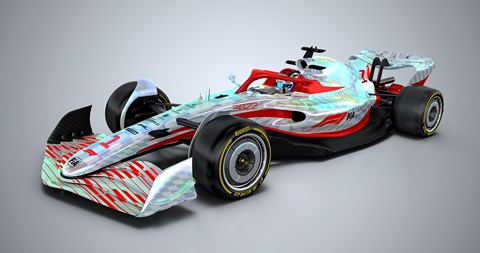► Here's a peek to the 2022 F1 cars
► It should be easier to follow
► And that should mean more overtaking
Formula One has revealed the new F1 2022 car ahead of the British Grand Prix later this week. Debuting one year later than planned thanks to the pandemic, it’s a strong peek at what the cars will look like next year.
Unlike the hastily constructed rules of the current season, the 2022 year car has been the result of development time and research, as the sport looks to improve overtaking. The idea is simple, by reducing turbulence coming off cars – and perhaps generating more downforce from the diffuser – it should be easier for racers to follow each other.

According to F1’s research, current cars lose 35% of their downforce when running three car lengths behind each other, growing to 47% when within one car length. It’s the latter figure you should pay more attention to, as it’s a distance where most overtakes will start.
The 2022 car generates more downforce on balance using the Venturi effect (or ground effect) than before, and that has a positive effect for those following. According to F1, three car lengths sees a 4% drop off in downforce, and one car length sees an 18% reduction.
What else is different?
The wheels are now 18-inches to better resemble road cars, and they’re treated more aerodynamically than before. There’s 2009-style wheel covers in place, and over-wheel winglets – both designed to manage the turbulence they're notorious for. The front wing is very different to the current regulations, too, and features huge swooping end fences reminiscent of an Indycar.
Engines will remain the same for until 2025, but the fuel they use will also be different next year. In addition to hybrid tech, F1 is banking on biofuel to keep things sustainable. Engines already run on 5.75% biofuel concoctions, but that’ll increase to 10% next year.

Why now?
F1 has always changed the rules at the wrong time, and it appears to be happening again. After the closest season in a while, the sport has started from scratch. Unfortunately, new regulations traditionally make for one-sided seasons, at least for a few years. For example, the last time the regulations were changed this much was in 2014…
Interview: Valtteri Bottas’s guide to tyre management
Has F1 become a spec series?
No, this is a generic car that follows the new rules. Rather than present teams with a set of written rules, this time around the FIA has actually employed a team to design a car that meets the criteria, and to then write rules that’ll fit around it. This team benefits from experience from the likes of Ross Brawn and Pat Symonds: both are well versed in exploiting regulations to their advantage.
Better yet, the FIA’s inhouse team has had unprecedented access to computational fluid dynamics (CFD) software, unlike teams who currently have to work around a cap.
According to the F1 sidde, the team has run approximately 7500 simulations, creating around half a petabyte of data.
'The wind tunnel testing we are doing is slightly different to what the teams might do,' said F1’s chief technical officer Pat Symonds on the F1 website. ‘The teams concentrate solely on the forces on the car, through a variety of attitudes as they move the car around.

'While we naturally have an interest in what those forces are and particularly how those forces change as the car moves, we’re even more interested in what is happening to the turbulent air behind the car.
‘The fundamental point of all of this is that we are trying to reduce the losses that the following car would face. The simplification of the leading car’s aerodynamics also helps for wake performance because on the one hand the front car doesn't have as many methods to control its wake. On the other hand the following car, not having all these little, very sensitive devices is less susceptible to disruption.'
We speak to Bottas at the Goodwood FOS
Anyway, what’s next for F1?
Now that the car and new rules appear to be in place, F1’s team of aerodynamicists will essentially try and break them. F1 has always been about looking for loopholes, and now with more CFD time behind them, it’s these areas where the F1 testers will try and narrow the wriggle room. Hopefully the car will still look as good when the teams come up with their own interpretations in 2022...
We’ll continue to update this story.